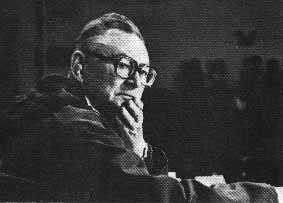NORTH SLOPE BOROUGH, P. O. BOX 69, BARROW ALASKA 99723
TELEPHONE (907) 852-2611
Issue No: Six_____________Part 1_____________Date:September, 1977
Hopson Says Whalers Will Hunt!
IWC HAS NO JURISDICTION OVER INUPIAT SUBSISTENCE WHALING RIGHTS
(Washington, D.C.)
 Charlie Watt, President, Northern Quebec Inuit Association, has become an important figure in the language politics of Quebec and the Canadian Federation. His defense of Inuit language rights in Northern Quebec has given courage to Quebec’s large Protestant English-speaking people to resist Quebec’s new French language charter, Bill 101.
Charlie Watt, President, Northern Quebec Inuit Association, has become an important figure in the language politics of Quebec and the Canadian Federation. His defense of Inuit language rights in Northern Quebec has given courage to Quebec’s large Protestant English-speaking people to resist Quebec’s new French language charter, Bill 101. Watt has called upon the Canadian government to exercise its trust responsibility to defend Inuit language rights.
His resistance may lead Ottawa to stop viewing the Land claims issue as “separationist” politics inspired by the separatism of French Quebec, and see the Inuit as a nationally integrated community of Loyal Canadians
Watt is shown here at the Inuit Circumpolar Conference last June in Barrow. He serves on the ICC Interior Committee. In Northern Quebec, it is hydroelectric development, not oil or gas, that is altering the Arctic Coastal Zone’s environment. In future issues of the Newsletter, the huge James Bay Project of Hydro-Quebec will be reported. Charlie Watt and the Inuit of Northern Quebec are in the middle of the greatest Arctic Coastal Zone energy development project in the world, larger than Prudhoe Bay and the Trans-Alaska oil pipeline in scope and importance. — Photo by Roderick
Department of Health, Education, and Welfare (DHEW) told State authorities that several millions in Federal education aid received annually by Alaska is endangered by widespread non-compliance of minimum Federal bilingual educational standards. She conducted hearings on this matter in Bethel and Nome in September, and will conduct hearings in Barrow in October. When she attended the University of Alaska’s Cross-Cultural Educational Conference in Greenland last July, Buchholdt was impressed with the high degree of integration of Greenlandic in all walks of life, and believes that Greenland may be an important part of the solution to the question of language rights protection in the American Arctic. However, Rep. Buchholdt points out that Native language instruction has become a matter of controversy, with such urban constituencies as hers (Spenard) taking a completely different view of language rights and language instruction than rural Alaska. The NSB has been working with educators in Alaska, Greenland, and Canada to develop a comprehensive, circumpolar approach to this social problem. Part of this was the creation of the NSB Inupiaq Language Commission which recently asked NSB Mayor Eben Hopson to initiate Inupiaq literacy training for all NSB staff, including non-Inupiats who do not now know how to speak Inupiaq. Eben responded by agreeing to do so, and asked for instructions on how to best conduct this training. At the same time, the Language Commission, chaired by Edna Ahgeak MacLean of the U. of A.’s Native Language Program, wrote to the Alaska Public Broadcasting Commission to request they place bilingual conditions on its support of Barrow’s public radio station KBRW. The Language Commission wants bilingual announcers, only, so important does it regard radio broadcasting to be in the defense of Inupiaq as a necessary language of Arctic survival.
Efforts to forge this kind of cooperation began in 1975, and came to bubble when NSB Mayor Eben Hopson met with the leadership of several National conservationist organizations at the D.C. Sierra Club headquarters in July, 1976. At that time, it appeared that the FOE were the best organized to help with Alaskan problems, with Jim Kowalski working full time to manage FOE affairs in Alaska, and Pam Rich working full time on Alaska land and resources politics in Washington, D.C. The NSB decided to funnel information to the conservationist community through Kolwaski and Rich. When the NSB chartered a jet to bring Greenlandic and Canadian delegates and observers to Barrow last June for the Inuit Circumpolar Conference, Pam Rich was on board as an important invited observer, and she played an important part in the work of the Conference. Since returning from Barrow to D.C., Rich worked hard to explain the Inupiat position to reluctant conservationists who had been influenced by the NMFS to regard Inupiat subsistence whaling very little differently than commercial whaling, and convincing the FOE board in D.C. to break what appeared to be solid conservationist ranks in support of the NMFS was a difficult, uphill fight.
The NSB’s efforts to organize a strong cooperation with conservationists was inspired by the successful model provided by the Inuvialuit of the Canadian Western Arctic. There the Committee for Original Peoples Entitlement (COPE), under the leadership of Sam Raddi, has developed a strong working relationship with the Canadian Arctic Resources Committee (CARC), a prestigious national environmentalist organization which published Oil Under the Ice to reveal Canada’s feckless Arctic oil development policy that threatens U.S. Arctic Coastal Zone environmental security due to the characteristics of the powerful Beaufort gyre. The NSB hopes to be able to work with national environmental organizations to bring public attention to the need for sound national and international Arctic policy development.
HISTORIC GATHERING OF WHALING CAPTAINS IN BARROW
Governor Hammond is a former Borough Mayor and has always insisted that he supports the NSB in its efforts to regain full revenue authority, and the NSB is inclined to believe him. The meeting in Barrow, which included Attorney General Avrum Gross; Public Safety Commissioner Richard Burton; and other top staff aides, enabled frank exchange that cleared lines of communication that had been neglected in the past because of distrust. The Barrow meeting with Hammond was followed up with a meeting between Hammond and Lewis Dischner, the NSB’s Juneau lobbyist, where Hammond instructed his staff to cooperate fully in aligning the NSB’s legislative program with his own. The NSB, which has had to resort to last-minute parliamentary maneuvers to pass its legislative program through previous sessions of the legislature, will now be able to depend upon the Governor’s office to help pass legislation badly needed by the NSB if rural Alaska is ever to be permitted to develop strong local government.
|
|
GOVERNOR APPOINTS COASTAL POLICY COUNCIL
Alaska Governor Jay Hammond announced his appointment of a 16-member State Coastal Policy Council, and an initial, introductory meeting of the CZM policy board was scheduled for September 29, 1977. The new Coastal Policy Council is made up of seven of the Governor’s cabinet, and 9 elected local government officials from coastal communities. NSB Mayor Eben Hopson was one of the local government officials appointed to the Coastal Policy Council. The others were Nome City Councilman Robert Fagerstrom; St. Mary’s City Councilman Stanley Paukan; Kodiak Borough Assemblywoman Betty Wallin; Anchorage Municipal Assemblywoman Lidia Selkregg; Kenai Borough Mayor Donald Gilman; Cordova City Councilman Malcolm Islieb; Juneau Borough Assemblyman Roger Allington; and Hydraburg Mayor Robert Sanderson. Each member will be allowed to name an alternate. With the lack of any important work on the agenda for the first meeting of the Coastal Policy Council, NSB Mayor Eben Hopson decided to send his assistant, Jon Buchholdt, as his alternate. The NSB hopes to convince the Coastal Policy Council to organize a strong Coastal Zone Management program from parts that already exist, such as the Federal/State Outer Continental Shelf Environmental Assessment Program; the State’s oil and gas leasing program; the Federal/State Land Use Planning Commission; the Federal/State National Petroleum Reserve — Alaska Task Force, and other State and Federal Programs already involved in coastal zone land and resource management in the Arctic and throughout the State. The NSB would like to see the Coastal Policy Council to get involved with the Beaufort near shore and OCS lease and exploration programs; the development of Alaska/Canadian Arctic caribou research and management cooperation; the concept of aboriginal offshore jurisdiction as part of Native subsistence hunting rights; and the development of coastal zone leasing regulations.
Whereas we the people of Gambell, living in common bond from time immemorial in present Geographical location, Gambell, Alaska, and Whereas our livelihood has been and still is dependent on the sea animal for food, clothing, equipment, and shelter, and
Whereas we the people of Gambell upon learning the bowhead whale has been identified as endangered species, and may be classified a depleted species and will no longer be hunted, and
Whereas our traditional ways and life style will be effected in our religious and customary traditions and practices and we the people of Gambell depend on the whale for (muktuk) for food and many customary (ceremonial) purposes and special community and family dinners, and
Whereas the sinew of the whale is used to sew our boat skins together, and to date nothing better has been discovered in its place, and
Whereas as our toboggans used for hauling other game meats home are made from baleen of the whale, and
Whereas the keel runners of our boats are made from the Whale ribs and jawbones, and
Whereas we use the oil from the whale blubber for many purposes, and
Whereas we the people of Gambell hunting whale from time immemorial catch an average of two whales annually, and
Whereas the catch amount would not greatly affect the whale population; and
Therefore, the people of Gambell are opposed to the proposed ban on subsistence taking of bowhead whales. We urge the National Oceanographic Administration to recognize the vital importance of the bowhead whale culturally and dietarily, and to recognize the severe economic hardship such a ban would cause. Such a needless ban, as suggested here, threatens the destruction of our way of life.
Garrett’s testimony presents an interesting review of the international politics of commercial whaling. He illustrated his narrative by quoting a Japanese newspaper article that appeared the day after the IWC reduced commercial whaling quotas in Canberra last June. The article explained that the Whaling Industry has insufficient political strength to force the Japanese government to object to the new IWC quotas because “America’s opposition to whaling is based on President Carter’s policy” and that a Japanese objection would “cause friction between Japan and the U.S., and that will spur criticism of trade with Japan.” Garrett went on to say that an objection by the U.S. to the IWC bowhead subsistence moratorium would result in a rash or other objections from whaling nations hurt by the lowered commercial quotas. He also threatened massive political retaliation by “elements of the conservation community” that will seek “Congressional action designed to eliminate many of the special hunting and fishing rights which the native people now enjoy,” if the U.S. should file an objection to the bowhead subsistence moratorium. Responding to questions by the hearing officer, Garrett had this to say about subsistence hunting and subsistence hunting rights:
MR. GARRETT: Let me say something about subsistence hunting. You know, the League of Nations in the 1931 Convention for the regulation of whaling is still listed as a treaty in force. That convention, as of January of this year, specifically prohibits the use of firearms in aboriginal whaling. It is clear that as parties to that convention, we have been flouting that particular international agreement for many years.
HEARING OFFICER DOLAN: Well, I think the domestic implementing legislation for the ’31 convention was repealed.
MR. GARRETT: But nonetheless the treaty remains in force, and one assumes since the treaty is in force that some of the contents are implicitly included. In any case, it is quite true that the ’36 enabling legislation was repealed.
HEARING OFFICER DOLAN: So you have any other comments on the regulation of subsistence hunting and the history of it?
MR. GARRETT: I would like to make a comment. I noticed in the last issue of Alaska magazine a statement by Arnold Brower — I don’t suppose Arnold Brewer regards me as a friend, but I have to regard Arnold Brewer as a friend until he knocks me over the head or something. Arnold Brower said that “We have not depleted the bowhead whale.” He is quite right. The Eskimos did not deplete the bowhead whale stocks. It was depleted initially by commercial whalers. Even if the bowhead stocks is now being depleted, it isn’t being depleted by Eskimos in the sense that Arnold Brewer uses the term “we,” because it’s not a hunt that’s being conducted by Eskimos in tune with their autochthonous cultural roots. Rather, I think the increasing hunt is evidence of the dissolution of the Eskimo culture. I believe the hunt, as it is present being conducted, and its current expansion, are in fact nothing more or less than a function of dissolution of the Eskimo culture, which is tragic but which is none-the-less happening.
HEARING OFFICER DOLAN: What’s the basis for that?
MR. GARRETT: Well, in the first place, the mode of whaling is not aboriginal. The mode of whaling is hybridized. It has elements of the original commercial whaling conducted in the area of the 1850s until 1921, or whenever the last coastal whaling for commercial reasons terminated. It uses the same archaic devices, the shoulder gun, and it is less efficient, of course, than the commercial whaling. Nonetheless, this is a sort of bastard culture, not used in the pejorative sense, of the methods that the commercial whalers brought in and the original Eskimo methods.
I think it’s becoming increasingly degraded now because it’s not being conducted even as it was being conducted fifteen or twenty years ago. Wastage is increasing; the blubber is no longer being utilized; the use of the shoulder gun, which the commercial whalers regarded as wasteful and which most of the captains forbade, most of the time at least, until after the animal had been hit with a harpoon, is increasing constantly; and inexperienced people are going out. Obviously the situation is out of control and obviously reflects less and less the autochthonous traditions of the Eskimo peoples.
HEARING OFFICER DOLAN: If there are no further questions, thank you very much, Mr. Garrett.
MR. GARRETT: I was expecting someone to nail me, but I guess they’re not going to. (laughter. )
Garrett’s testimony is quoted in the Newsletter because it fairly reflects what he and NOAA’s William Aaron have been telling the IWC and the IWC’s Scientific Committee about the sanctity of Inupiat aboriginal subsistence whaling rights.
A check with the dictionary determines that “bastard” as Garrett used the word to describe the Inupiat whaling culture, is defined as “not genuine, sham, inferior.” In short according to Garrett, not “autochthonous”, from the word autothon, “sprung from the land itself; any of the earliest known inhabitants of a place; aboriginal.” (Second College Edition, Websters, 1974).
The theme that aboriginal subsistence hunting rights erode through acculturation has been the theme of the American game management industry since its origination in early Colonial America, and Garrett’s testimony merely restated an argument that resulted in the near annihilation of Native Americans during the 19th century. The NSB was started to hear this argument being used in public in 1977.
|
A POEM FOR THE CONFERENCE
|
||||

